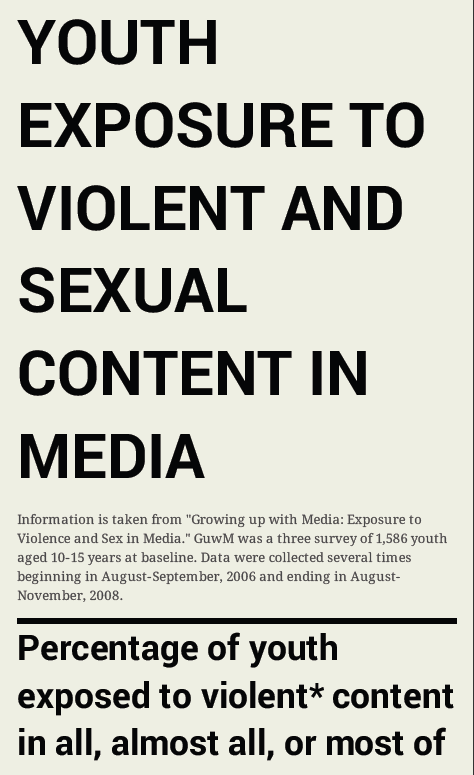 Infographic on youth exposure to violence and sex in media
Infographic on youth exposure to violence and sex in media
Researchers, public policy officials, and the general public as a whole have long been concerned about the consequences of youths’ exposure to violence and sex in the media. Recent studies have documented the explosion of different types of media available to youth [1, 2] and the widespread presence of violence in these media outlets.[3]
With the increase in new media, it is important to first gain a current understanding of how many youth are exposed to violent and sexual content and where this content exposure is occurring (e.g., video games, television, Internet websites) before further investigation into the consequences of such exposure.
We examined the frequency of youth exposure to violent and sexual content in media in, “Growing Up With Media: Exposure to Violence and Sex in Media”
Check out this infographic to see the results:
Youth Exposure to Violent and Sexual Content in Media
Acknowledgements:
The GuwM Study was funded by a Cooperative Agreement with the Centers for Disease Control and Prevention (U49/CE000206; PI: Ybarra). Points of view or opinions in this bulletin are those of the authors and do not necessarily represent the official position of policies of the Centers for Disease Control.We would like to thank the entire Growing up with Media Study team: Internet Solutions for Kids, Harris Interactive, Johns Hopkins Bloomberg School of Public Health, and the CDC, who contributed to the planning and implementation of the study. Finally, we thank the families for their time and willingness to participate in this study.
Based on:
Korchmaros J., Lopez E., Mitchell K., Prescott T., and Ybarra M. Growing up with Media: Exposure to Violence and Sex in Media. San Clemente, CA: CiPHR. January 2012.
References:
1. Lenhart A, Madden M, Hitlin P. Teens and technology: Youth are leading the transition to a fully wired and mobile nation. Washington, DC: Pew Internet and American Life; July 27 2005.
2. Roberts DF, Foehr UG, Rideout V. Generation M: Media in the lives of 8-18 year olds. Menlo Park, CA: The Henry J. Kaiser Family Foundation;2005.
3. Wilson B, Kunkel D, Linz D, et al. Violence in television programming overall: University of California, Santa Barbara study. In: Seawall M, ed. National television violence study. Thousand Oaks, CA: Sage Publications; 1998:3-184.
